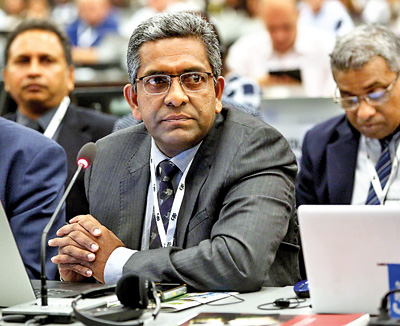News
External experts devise clever ways to protect wildlife
View(s):WildLanka is the annual symposium of the Department of Wildlife Conservation that brings together wildlife researchers and administrators of the country. All keynote speeches were delivered by experts from other fields – one was an ICT expert, while the other two are engineers.

DWC head Chandana Sooriyabandara at the symposium
Innovative solutions devised collectively by experts are needed to address wildlife challenges, was the message that emerged from speeches at a symposium on ‘Innovation for Conservation’, held at Waters Edge from September 2-3.
The first speech was delivered by the group chief information officer and the center head for Virtusa Sri Lanka, Madu Ratnayake.
“When we say innovation, often the technological innovation comes into our mind. But there can be innovation in other means that can help to achieve conservation successes. The way we work, methods, work process are some of the areas that can be improved by innovation,” he said.
Delivering the keynote address on “Using Technology in protecting wildlife and mitigating human-wildlife conflicts,’’ Mr Heminda Jayaweera, the chief operating officer of the Sri Lanka Institute of Nanotechnology, stressed the importance of identifying the issue before providing a solution.
The engineer said that innovative solutions can emerge from the collective efforts of experts from different fields.
The Minister of Wildlife and Tourism, Mr John Amaratunge was chief guest of the WildLanka symposium.
“Through WildLanka, the department aims to encourage research on wildlife, which is required in taking management decisions in conservation. More importantly, we want to improve the research capability of the department itself, while encouraging wildlife officers to carry out more research on relevant fields,’’ said Chandana Sooriyabandara, the director general of DWC.
Held for the sixth year, WildLanka 2019 witnessed 46 research papers. Twenty of these were presented by wildlife officers of the DWC and the rest by researchers at universities and other institutions. The presentations were judged by experts and recognised at the end of symposium.
The research papers based on presentations made at the symposium are published in WildLanka, the journal of the department. The DWC has been publishing this quarterly science journal since 2006. The symposium is its annual event.
“WildLanka is a peer-reviewed journal where the papers are assessed for accuracy and quality by an editorial panel of experts. Experts from India, Malaysia and the US are also part of the WildLanka editorial board,” said Chief Editor, Ms Nilanthi Rajapakse.
There has been a gradual increase in the contribution of research papers to the WildLanka journal and it is encouraging, she said. For example, over 75 papers were presented at the symposium, whereas only 46 was selected, Ms Rajapakse, said.
A deputy director of DWC, Ranjan Marasinghe, said the department also tries to use technology in conservation and management
The DWC introduced the SMART (Spatial Monitoring And Reporting Tool) patrolling in a number of national parks to measure, evaluate and improve the effectiveness of wildlife law enforcement patrols and site-based conservation. SMART helps the patrolling groups to collect field data.
| Technology tools for wildlife research | |
| The three-day symposium of Association of Tropical Biology and Conservation’s Asia-Pacific chapter (ATBC-AP) held this week involving about 400 scientists (with half of them foreign) working on tropical biodiversity also demonstrated instances of using innovative methods in wildlife study. Lakimini Abeywardhana, who studied IT and is doing post-graduate studies at University of Colombo, presented her research developing an application to identify tiger beetles. This is a rare groups of bugs and this illustrates how experts from different fields can assist wildlife research. “This was started towards the end of 2017. Not having images due to their endemicity and rareness has been an issue and I’m now trying to increase the accuracy of the app with limited images,” she said. Tharaka Kusuminda, a doctoral student at University of Ruhuna illustrated how he used sound to identify the bat species, the painted bat. “Bats use ultrasound to find their pathway and food and these are out of our hearing range. To be sure whether a particular species of bat is in an area, rigorous observation has to be done. Sometimes, you need to catch one. But I identified the frequency of the painted bat and now we could record the sound and by analysing, we could find out the presence of painted bats,’’ Mr Kusuminda said. Catharina Karlsson, a researcher of frogs, shared information about innovative identifying devices she used for her doctoral study at Malaysia’s Kinabalu Park. “There are about 15 species of frog in the study, but they are so tiny and usually hidden under logs and so on. But each species has a unique sound, so I developed a device to record the sound. Its analysis helped to identify the frog,” said Ms Karlsson. “It was not easy. The devices failed initially, but with the assistance of my father in assembling the electronic devices properly, I could gain the results,” she said. |

